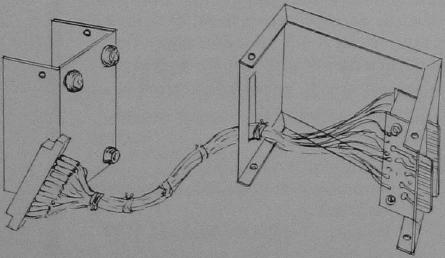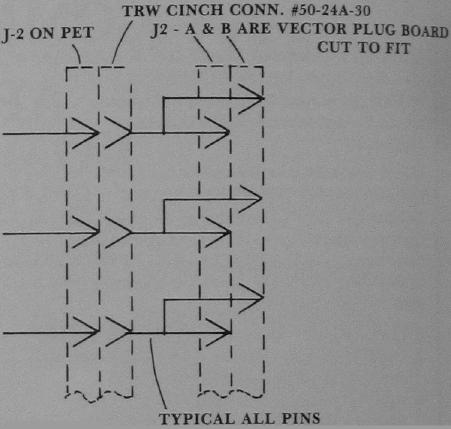Micros With The Handicapped
Susan Semancik,
The Delmarva Computer Club
Our activities at the Marine Science Center (see Issue #7) also involved the testing of several devices that we hope will have further applictions, not only for the handicapped, but for any serious computer user. One complication that arises when trying to use alternative inputs for the handicapped, is that only one device at a time can have access to the eight data lines of the User Port. When working with the blind, especially, it is often desirable to have not only an alternative input device, but also a vocal output device controlled by the computer. It is possible on the User Port to simultaneously assign some of the data lines as input and some as output, but this is not sufficient if eight lines are needed in each direction.
What we tried, and have had success with, is a simple, inexpensive device that converts the User Portís edge into a dual edge. One edge is used by an output device, and the other by an input device that are alternately serviced by the PET.

Diagram 1 shows how this device is connected to the PET, and Schematic 1 shows how it is wired. In diagram 1, the bottom of the metal box containing the wiring has four foot pads on it and is shown on the left side of the diagram, removed from the box, with an edge connector to the User Port in front of it. Each pin of this edge connector is connected with either #22 or #24 wire to two printed circuit cards that were cut from prototype boards that can be purchased at Radio Shack. Three typical pins from this connection are shown in Schematic 1, showing how the female connection from the PET is wired to the two male connection on the printed circuit cards. This device can be built for approximately $10. To use the device, plug its edge connector into the User Port, and attach the edge connectors from two of your peripherals to the exposed portions of the printed circuit cards. Make sure one peripheral will be used only as input and the other only as output, and that each uses TTL I/O Logic Levels and has buffered outputs.
The input device we chose to use is Innovisionís Prestodigitizer Board, for which we have written programs to enter either Braille code or Morse code. (See Issues #5 and #6.) The output device we used is a modified TI Speak-and-Spell, whose keys can be controlled by a PET computer. We are currently investigating accessing the Speak-and-Spellís vocabulary by computer, and hope to eventually use it with the PET as an inexpensive speech synthesizer.

We modified the Braille program for the digitizer board so that as a letter is entered in Braille code on the board, the Speak-and-Spell vocalizes that letter. Because of the active, noisy environment, the students stayed close to the Speak-and-Spellís speaker. This system was especially appreciated by the blind students because they could use a code they were familiar with to enter messages on the PETís screen. This allowed communication one way between the blind who couldnít sign and the deaf who couldnít speak. The program will be modified further so that communication can flow the other way, too. That is, when the deaf type on the PETís keyboard, the letters will appear on the screen and be simultaneously vocalized. Certainly this second way could also be used by a blind person familiar with a typewriter keyboard. We would also like to modify this program so that a message entered from the PETís keyboard or from the digitizer board could be repeated with a single keystroke.
We gained many valuable insights from our experiences at the Marine Science Centerís summer workshop for the handicapped. All of our programs were greeted by the intended users with a great deal of enthusiasm and positiveness. We hope to continue exploring these and other ideas we have for aiding the handicapped, and will share our experiences with you through this column.
We have heard from many readers who wish to encourage our efforts, and some who wish to support us in any way they can. Some have even offered to share their experiences as handicapped computer users with us through this column. We hope others will also volunteer to share their experiences so that a much needed dialog can be encouraged in this area with many problems and solutions. We would also like to encourage feedback from readers on programs we are offering here for the handicapped.
The Delmarva Computer Club
P.O. Box 36
Wallops Island, VA 23337